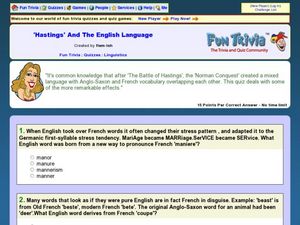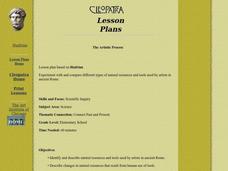Carstens Studios
Math Doodles
Discover the joy and excitement of improving your math fluency through four different puzzles. Combine those with 25 different ways to represent numbers and you have hours of enjoyment that can be fun outside of the classroom as well.
Curated OER
Season Sarcophagus
Students analyze a sarcophagus art and create a similar piece of art. In this sarcophagus art lesson, students investigate possible meanings of the Season Sarcophagus and create a work of art that is similar to the subject or meaning of...
Curated OER
Bocce Ball - Lesson 1 - Rules and Courtesies
In between fighting, Roman soldiers played this game for their amusement. What is the game? Bocce ball, a form of lawn bowling which the Italians brought to the US. This sport can be played by anyone who can roll a ball that is about the...
Curated OER
'Hastings' and the English Language
Follow the development of the English language from its Anglo-Saxon roots. Various Germanic, Roman, and French words helped form our English vocabulary and are incorporated into this quiz. See how well you know the beginnings of English...
Virginia Department of Education
Synthesizing to Support a Thesis- Big Picture Emphasis
Help your researchers as they begin to develop a topic for research with these worksheets. Included are two nicely designed graphic organizers that assist students in narrowing and researching their topic, and an efficient evaluation...
Curated OER
Sophocles' Antigone: Ancient Greek Theatre, Live from Antiquity
Students analyze Antigone and its universal issues as well as explore ancient Greece. In this Antigone and Ancient Greece lesson, students read and complete activities for Sophocles' Antigone. Students reconstruct the experience of a...
Curated OER
Giants of the Past
Students listen to the book, The Mysterious Giant of Barletta, and create paper sculptures based on ancient Greek and Roman statues in the Getty Museum. They write narrative stories told from the viewpoints of their sculptures.
Curated OER
Spice Container
Sixth graders examine and identify classic Greek and Roman motifs on spice containers. They analyze the process of casting and chiseling silver, and design and create a spice container using classic Greek and Roman design elements.
Curated OER
No Title
Students explore and analyze various Roman artifacts to assess how they survived over time, their organic materials, categories and images. They evaluate Roman, silver, and bronze coinage for their emperor's titles and depict mythical...
Curated OER
Honoring Leaders
Students design and compare monuments that honor an imaginary Roman emperor and a future American president. They explain how the monuments reflect the attributes of the person being honored.
Curated OER
Following the Leaders
Examine the historic election of Pope Benedict XVI and reflect on the challenges he faces as the new leader of the Catholic Church. This New York Times lesson investigates how other world leaders are chosen in different forms of...
MENSA Education & Research Foundation
Utopia/Dystopia: The American Dream
America was founded by dreamers, and the American dream still resonates in our country today. Track the American dream from its Puritan beginnings to its optimistic descendants with a instructional activity that focuses on speeches by...
Curated OER
Civilizations Leadership
Students view a segment of Prosperity and Decline. They discuss what attributes made the empire strong. Students discuss what caused the fall of the Roman Empire. They write an essay describing the cause of the fall of the Roman Empire....
Curated OER
Civilizations The Fall of Power
Students comprehend the major events that occurred in the final centuries of the Roman Empire. They explore the different reasons for the fall of the Roman Empire. Students write an editorial about one reason for Rome's fall.
Curated OER
The Artistic Process
Students experiment with and compare different types of natural resources and tools used by artists in ancient Rome. They describe changes in natural resources that result from human use of tools.
Curated OER
Dolls in Tunics & Teddies in Togas
Young scholars identify the basic components of male and female Roman
costume, both for children and adults and also, the major social ranks of Imperial Rome and the dress reserved for each gender and rank. They also identify some of the...
Curated OER
Julius Caesar is Dead
In this Julius Caesar worksheet, students learn about the death of Julius Caesar. Students study the picture and learn the importance of the date March 15th.
Curated OER
Tracing the Roots of Modern Cities
Pupils identify several key inventions and other forms of technology that were part of city life during the classical Roman and Greek periods. They report on one characteristic or invention that is shared by modern and ancient cities.
Curated OER
Casa Romuli
In this language arts worksheet, students read the definition of the Hut of Romulus. They look at the map that describes the seven hils of the Roman Empire also.
Curated OER
Classical Mythological Monsters
Students, after researching and analyzing ancient Greek and Roman mythological monsters, create a monster of their own similar to one they've researched or studied in their class syllabus. In addition, they present their creations to the...
Curated OER
Comic Theater
Students explore stock characters and pantomime. In this comic theater lesson, students examine an ancient Greek statuette depicting a comic actor and an ancient Roman lamp decorated with a comic mask. Students pantomime short scenes and...
Curated OER
Julio-Claudian Emperors
In this Roman history worksheet, students read an excerpt about the emperors of the Roman empire between 27 BC and AD 476. They research on the Internet the website given to find the answers to the first six questions. Once the students...
Curated OER
Horse Warriors
Students compare the Roman Empire, medieval Europe and feudal Japan. In this warrior societies lesson, students research the 3 warrior societies and share their research findings with their classmates.
Curated OER
Digging Into the Past
Students participate in an excavation simulation, and explore the ruins of Sardis. They ponder which clues scientists use to determine if artifacts found in the excavation are of Persian, Greek, Roman, Byzantine, or Lydian origin.
Other popular searches
- Roman Empire
- Roman Republic
- Roman Numerals
- Roman Mythology
- Achievements of Ancient Rome
- Ancient Rome Geography
- Ancient Rome Government
- Greco Roman Art
- Ancient Rome u.s. Government
- Ancient Rome Projects
- Roman Architecture
- Fall of Ancient Rome

























